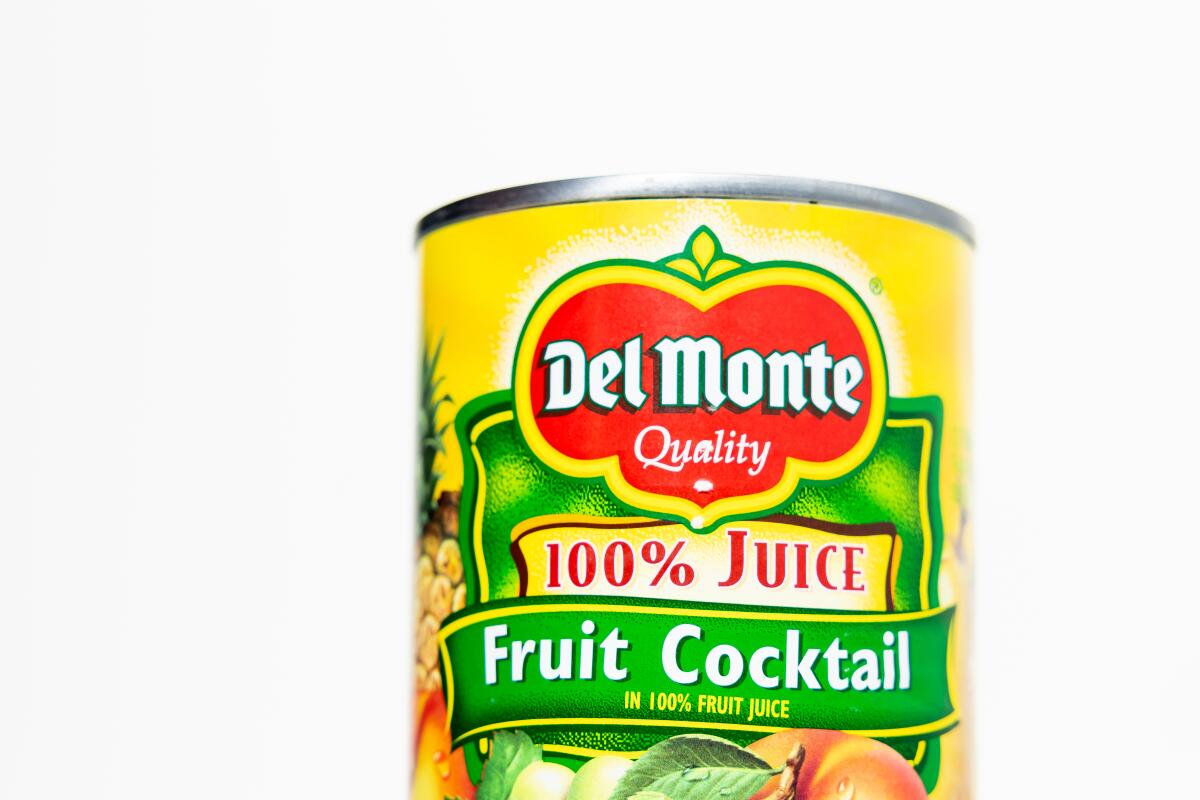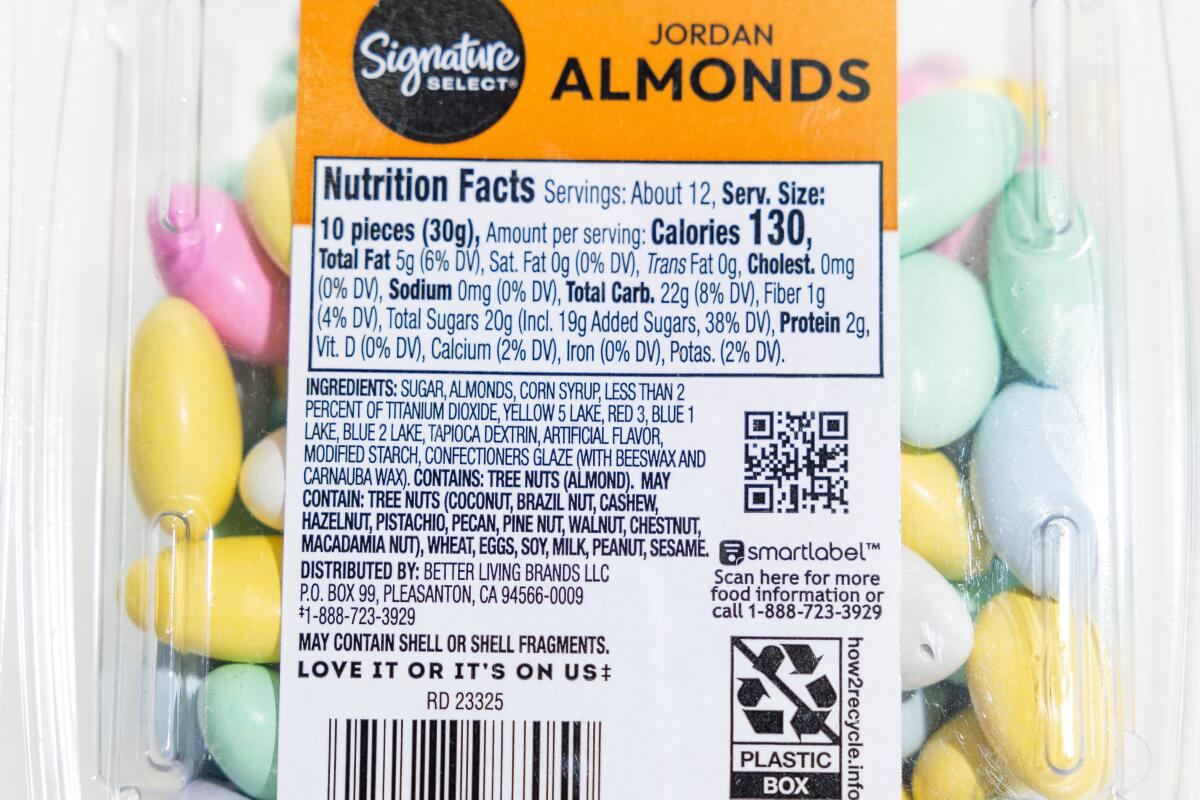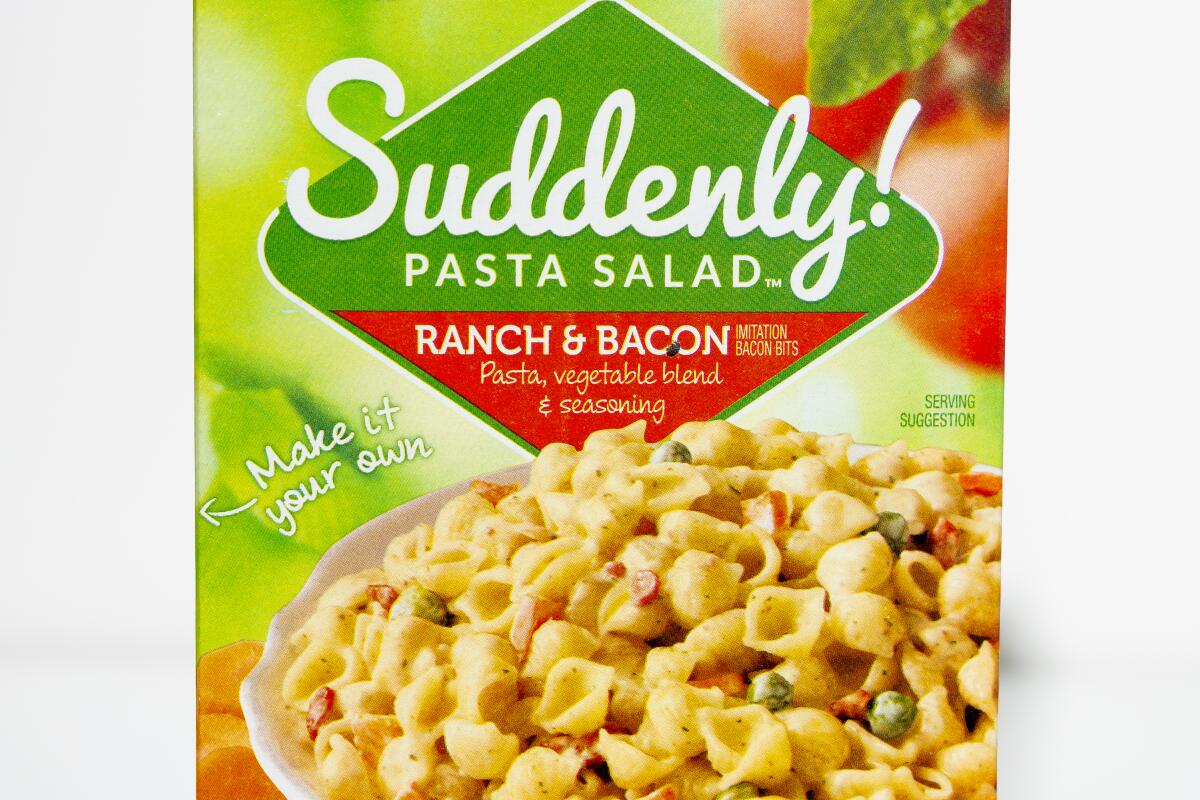The FDA knew long ago that red dye No. 3 causes cancer. Why did it take so long to ban it?
The Food and Drug Administration said Wednesday that the much-maligned red dye No. 3 will be banned in the United States because it has been shown to cause cancer in animals.
The decision, lauded by consumer advocacy groups, comes a full 25 years after scientists at the agency determined that rats fed large amounts of the artificial color additive were much more likely to develop malignant thyroid tumors than rats who weren’t given the food coloring. They also had an increased incidence of benign tumors and growths that can be precursors to cancer.
Those findings prompted the FDA to declare in 1990 that red dye No. 3 could not be used in cosmetics or drugs applied to the skin. The reason for the decision was clear: A federal law known as the Delaney clause says no color additive can be considered safe if it has been shown to cause cancer in animals or people.
Yet the dye remained a legal food coloring. It’s in the bright red cherries that dress up a bowl of Del Monte’s fruit cocktail. It makes Nesquik’s strawberry milk a pleasing shade of pink. It also colors beef jerky, fruit rolls, candy, ice cream and scores of other processed products.
Now food makers will have two years to reformulate their products without red dye No. 3. Drug companies have three years to remove it from their medicines.
The FDA does not seem to be bothered by the fact that this cancer-causing chemical will linger in the food supply. The agency’s view is that the biological process through which the dye causes cancer in rats doesn’t occur in people.
“We don’t believe there is a risk to humans,” Jim Jones, the FDA’s deputy commissioner for human foods, told members of Congress last month.
In announcing the ban, the agency added that people consume red dye No. 3 at levels far lower than those shown to cause cancer in two studies of rats. A host of other studies in both animals and humans did not show the dye to be cancerous.
Nonetheless, regulators revoked authorization of red dye No. 3 to satisfy a petition demanding that the Delaney clause be enforced.

Starburst-flavored Fruit by the Foot, which contains red dye No. 3. (Christina House / Los Angeles Times)
“Regardless of the truth behind their argument, it doesn’t matter,” said Jensen N. Jose, regulatory counsel for food chemical safety at the Center for Science in the Public Interest, which spearheaded the effort. “Once it’s established that it causes cancer, FDA must prohibit the chemical by law.”
This wasn’t the first case of the FDA banning a food additive it considers safe to comply with the Delaney clause. The situation shows why the federal law is long overdue for a refresh, food safety experts say.
“A lot of people think we need to reform this,” said Diana Winters, deputy director of the Resnick Center for Food Law and Policy at UCLA Law. “It does lead to some absurd results.”

The Delaney clause is part of a 1958 federal law that expanded the FDA’s regulatory authority over newfangled food additives developed during World War II that were making their way into consumer products, Winters said.
Back then, members of Congress were worried about the cancer risks posed by all sorts of man-made compounds. Even small amounts seemed capable of triggering cancerous growths if people encountered them over and over again.
Arthur Flemming, who served as President Eisenhower’s Cabinet secretary for health and welfare, told Congress at the time there was no way for FDA regulators to know whether any exposure level was low enough to be truly safe. Considering the many cancer risks lurking in the environment, he said, the government should “do everything possible to put persons in a position where they will not unnecessarily be adding residues of carcinogens to their diet.”


Signature Select rainbow cups, which contain red dye No. 3.
(Christina House / Los Angeles Times)
The issue was personal for Rep. James Delaney, a Democrat from New York City whose wife was undergoing cancer treatment at the time. He made sure the new law included a zero-tolerance provision for cancer-causing substances, though it said nothing about additives that might cause other kinds of health problems.
“No additive shall be deemed to be safe if it is found to induce cancer when ingested by man or animal, or if it is found, after tests which are appropriate for the evaluation of the safety of food additives, to induce cancer in man or animal,” the Delaney clause states. A 1960 amendment governing color additives extended the rule to dyes.
As the years went by, advances in toxicology allowed scientists to expand the list of known cancerous compounds, and to identify them in ever-smaller amounts. Regulators were no longer as clueless as they’d been in Flemming’s day.
In 1986, the FDA tried to take that progress into account as it evaluated the safety of two color additives — orange dye No. 17 and red dye No. 19 — for use in lipsticks, nail polishes, face powders and other cosmetics. The agency acknowledged that both dyes were capable of inducing cancer in laboratory animals. But it argued that the regulatory decision should be guided not by a literal interpretation of an aging law but by the real-world risks to people.
When those color additives were used as intended, those risks were vanishingly small: A panel of scientists from the U.S. Public Health Service determined the lifetime cancer risk posed by the red dye was 1 in 9 million at worst; for the orange dye, it was 1 in 19 billion. In both cases, the possibility of developing cancer was “so trivial as to be effectively no risk,” the panel concluded.
A federal appeals court agreed that the dyes seemed to be safe. In fact, the risks they posed were millions of times lower than the risks of smoking, the judges wrote.
Moreover, the judges noted, forbidding the use of chemicals that carry a minute risk of cancer might prompt manufacturers to use compounds that are more toxic, albeit in noncancerous ways. Substitutions like these would be “a clear loss for safety,” they wrote.
But none of that matters, the court ruled: If a dye or any other chemical is found to cause cancer in animals, the FDA’s only option under the Delaney clause was to forbid its use.


Nestle Nesquik strawberry milk, containing red dye No. 3. (Christina House / Los Angeles Times)
Regulators found themselves in a more absurd situation in 2018 when they were asked to revoke their authorization of a flavoring additive called myrcene.
When the synthetic compound was force-fed to rats at doses of 1 gram per kilogram of body weight for two years, the animals developed kidney cancer and other forms of renal disease. Female mice fed under the same conditions developed liver cancer as well, the FDA said.
But the amount of artificial myrcene consumed by a typical American is 813,000 times lower — around 1.23 micrograms per kilogram of body weight, the agency said.
Moreover, myrcene is a natural component of mangoes, citrus juices, cardamom, and herbs including basil, parsley and wild thyme. The amount of natural myrcene in the food supply is about 16,5000 times greater than its synthetic counterpart, the agency added.
Still, the FDA declared the additive unsafe “as a matter of law” while assuring the public that no one’s health was actually at risk when synthetic myrcene was on the market. It blamed the Delaney clause for the confusion.
In 2020, a group of food industry scientists said the problem goes well beyond confusion. Revoking approval for artificial myrcene “has contributed to the ongoing erosion of trust in regulatory agencies,” they argued in the journal Regulatory Toxicology and Pharmacology. Such decisions promote an irrational fear of chemicals and cause consumers to lose faith in the safety of the U.S. food supply, they wrote.

Red dye No. 3 was approved for use in U.S. food in 1907, when it was known as erythrosine. It won permanent listing as an authorized color additive for foods, supplements and ingested drugs under the name FD&C Red No. 3 in 1969.
Soon after that decision, an industry group called the Toilet Goods Assn. petitioned the FDA to upgrade the dye’s listing for cosmetics and topical drugs from provisional to permanent. The request triggered additional tests in the 1970s and ‘80s, including two long-term feeding studies in rats.
Beginning before birth and for their entire lives, the animals were put on diets that included the red dye at concentrations of 0.1%, 0.5%, 1% or 4%. Compared to male rats that didn’t consume any dye, male rats that ate the most had a significantly higher incidence of tumors — both malignant and benign — as well as abnormal cell growth in the thyroid. No other group had an increased incidence large enough to be considered statistically significant. Among female rats, the incidence of benign tumors was elevated for those on the 1% diet, though not for rats on the 4% diet, as would be expected if the dye were the cause of cancer in these animals.
After consulting with scientists from the National Toxicology Program and the U.S. Public Health Service, the FDA concluded that red dye No. 3 could cause cancer in animals. In 1990, the agency denied the industry group’s request for permanent listing.
That decision applied only to cosmetics and topical drugs, and had no immediate bearing on food products sold in the U.S. At that point, the dye had been permanently listed as an approved food additive for decades. Nothing in those rat studies indicated to the agency that its designation needed to change.
Over the years, the dye has been tested in mice, rats, gerbils, pigs, beagles and humans. An extensive review conducted by the World Health Organization and the Food and Agriculture Organization of the United Nations found “no concerns” about the dye’s ability to trigger cancer, impair fertility or cause developmental problems in people of all ages when consumed in realistic doses.
“Claims that the use of FD&C Red No. 3 in food and in ingested drugs puts people at risk are not supported by the available scientific information,” the agency said Wednesday.


Frosted sugar cookies from Favorite Day Bakery, containing red dye No. 3.
(Christina House / Los Angeles Times)
Pitting the Delaney clause’s strict legal requirements against advances in cancer research has been a longstanding challenge for the agency, officials said.
“When we ban something, it will go to court,” Dr. Robert Califf, the FDA’s commissioner, told the Senate Health, Education, Labor and Pensions committee last month. “And if we don’t have the scientific evidence that will stand up in court, we will lose in court.”
The elaborate regulatory process for removing an additive from the food supply can certainly result in litigation, said Emily Broad Leib, director of the Center for Health Law and Policy Innovation at Harvard Law School.
“The Delaney clause probably works a lot better at the outset if you’re trying to add a new substance to food,” she said. “Once things are in food, it takes a really long time to remove it.”
The way some people see it, the problem with the Delaney clause isn’t that it forces the FDA to ban food additives that don’t pose a true cancer threat. It’s that the law doesn’t address all the other ways the foods we eat can be hazardous to our health.
“There’s a lot of things in foods naturally that cause cancer, and the Delaney clause doesn’t cover that,” said Alyson Mitchell, a food scientist at UC Davis. “It also does not speak to anything regarding other illnesses, whether it’s kidney dysfunction or ADHD or mental health issues or endocrine imbalances.”
The General Accounting Office (now known as the U.S. Government Accountability Office) raised this issue back in 1981, when it advised Congress to update the Delaney clause to reflect the latest scientific and medical knowledge. It would make sense for the law to apply “ equally to cancer-causing and non-cancer-causing substances,” the GAO said.




Other items that contain red dye No. 3: Del Monte fruit cocktail, Signature Select Jordan almonds, Betty Crocker Suddenly! pasta salad, and Jack Links beef stick and cheese. (Christina House / Los Angeles Times)
California has banned all uses of red dye No. 3 in the Golden State, and prohibited the use of six other dyes in foods served or sold in schools. Scientists who examined the dyes for the California Office of Environmental Health Hazard Assessment determined that “the behavioral factors are more of a concern” than the cancer risk, said Asa Bradman, an expert on exposure assessment and epidemiology at UC Merced and co-author of the comprehensive state report.
The FDA has studied the behavioral risks of color additives and hasn’t found “a clear and causal link,” an FDA spokesperson told The Times. Studies suggest some children with behavioral challenges like ADHD appear to be sensitive to food dyes, and that genetic variants affecting the body’s ability to break down histamine are a likely cause. In the FDA’s view, that doesn’t mean the dyes themselves are “neurotoxic,” the spokesperson said.
If there was convincing evidence that an artificial dye failed to meet FDA’s safety standards, the agency would take action whether the health threats were covered by the Delaney clause or not, the spokesperson added.
Mitchell, who worked on the California report with Bradman, said that because manufacturers have been phasing out red dye No. 3 for more than a decade, it’s not a significant concern for her. She’s more worried about the hyperactivity risk posed by red dye No. 40 because it’s ubiquitous in processed foods, especially those consumed by children.
“I’m grateful for the Delaney clause because I do think it’s been very helpful in trying to protect our food,” Mitchell said. “But it doesn’t go far enough. So much of this needs to be revisited.”

